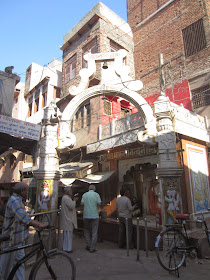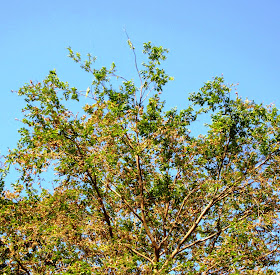Rani Bagh Botanical Garden was in my to visit list since many a days. Though I had visited Bhau Dhaji Lad Museum, had missed the Botanical Garden. When I received an e-mail from
Sanctuary Asia for a guided nature trail, I didn't want to miss the opportunity.
We joined the Sanctuary Asia team and other attendees of the trail at Botanical Garden by 7:30AM. One of the members of Save Rani Bagh Botanical Garden Foundation introduced us to Rani Bagh and Save Rani Bagh Botanical Garden Foundation.
Rani Bagh: Formerly called Victoria Garden, Rani Bagh was laid out in 1861 The garden houses the Jijamata Udyaan(also known as Byculla Zoo/Mumbai),
Dr. Bhau Daji Lad Museum, Gaint staue of Elephant from Elephanta Caves and the Clock Tower. The Fort area, reflects the British rule, every building and monument here is inter related. Its said that the Flora Fountain, was proposed for Rani Bagh, which was later laid at its present location. The statue of
King Edward VII(Kala Ghoda), from Kala Ghoda was removed and mounted here in Rani Bagh in 1965.
Rani Bagh is a 53-acre heritage botanical park (over 150 years old) in the heart of the city. Its the city’s largest green open public space and much needed green lung which is home to over 3,213 trees and a total of 853 plant species, providing a verdant habitat for thousands of birds, insects and bats.
Save Rani Bagh Botanical Garden Foundation: Unfortunately, in 2007, the Brihanmumbai Municipal Corporation (BMC) announced its plan of setting up a zoo to international standards at a cost of Rs. 433 crore. Realising that such a huge expense would entail construction activity on an enormous scale and that was no treeless space available in the botanical garden for further construction, a group of friends formed the Save Rani Bagh Botanical Garden Committee and set about gathering information and marshalling public support to oppose the BMC’s plan. Their main focus was to protect for posterity the existing 150-year-old botanical garden in the heart of the city with huge age-old majestic trees. After a five year struggle, the Save Rani Bagh Committee was able to convince the Mumbai Heritage Conservation Committee to reject the BMC’s international zoo proposal. Thereafter, the BMC was ordered to make a smaller plan only for the renovation of existing animal enclosures. In 2012, they founded a Public Charitable Trust - Save Rani Bagh Botanical Garden Foundation - to generate greater awareness about the botanical garden and to strive to enhance its many features.
After the brief introduction to the Botanical Garden, the team was divided into two groups and our group, headed by Katie Bagli started off with the trail. The park has trees from around the world, planted during British rule.
As we entered the zoo, we were asked to collect the fallen crunchy seeds spread over the ground. The seeds of Chilbil/Cork Tree(Botanical name: Millingtonia hortensis L.f, native to Myanmar, Malaya), also gets its name Monkey chips, as they are favourites of monkeys. A thin papery layer holds the seeds with-in and helps in dispersal, as blown away by wind due to its light weight.
The two gaint Baobab trees(Botanical name: Adansonia digitata L., native to Tropical Africa) on the either side of the entrance path of the park, stood as, huge gaurds welcoming us. The truck of the tree is hollow. Its said, a large, hollow baobab was used as a prison for convicts in south of Derby, Western Australia, in the 1890s.
 |
| Baobab Tree |
 |
| Baobab Tree |
Next was the Guest tree(Botanical name: Kleinhovia hospita, native to Archipelago, Malaya), which produces star shaped flowers. Its also called Jewel Box, because of the bead shaped seed it holds in its shallow chest.
Cajeput(Botanical name: Melaleuca cajuputi Powel, native to Australia), is known for its soft/spongy bark, which easily flakes of the trunk. Its also called paperbark tree or punk tree).
 |
| Cajeput Tree |
 |
| Feeling the spongy texture of Cajeput tree |
Tad(Botanical name: Borassus flabellifer, native to India, Srilanka, Myanmar), from the palm family, called as Taati Nungu in Kannada and Tadgola in Marathi, produces a coconut like fruit when cut off reveals three sweet jelly seed sockets.
 |
| Tad Tree |
Beheda(Botanical name: Terminalia bellerica, native to India) and Hirda(Botanical name: Terminalia chebula, native to India), are the two of the three medicinal plants, which constitute Triphala churna(the third being Amla). These have digestive and anti-inflammatory properties and hence useful in constipation.
 |
| Hirda and Beheda Trees |
Kailashpati/Connonball Tree(Botanical name: Couroupta guianensis Aubl., native to South America), the fruit resembles cannonball, and the flower resembles snake and grown in Shiva temples, hence the name Kailashpati.
 |
| Cannonball Tree |
Oil palm(Botanical name: Elaias guineensis Jacq, native to Tropical Africa), its fruit is used to extract oil(palm oil).
 |
| Oil Palm Tree |
Indian Rubber Tree(Bonatical name: Ficus elastica, native to Assam, Burma): The original rubber tree was native to Brazil and till many years Brazil had the monopoly of producing rubber. British commercialised the cultivation of the Indian rubber to have their supremacy in rubber production.
 |
| Indian Rubber Tree |
Samudra Phal(Botanical name: Barringtonia asiatica, native to Andaman, Manmar), its grown along the street for decorative and shade purpose in some parts of India. The fruit is extremely water resistant and survive a float upto 15years. So, its said to be dispersed from Andaman to reach coastal India, hence introduced in India.
 |
| Samudra Phal |
 |
| Samudra Phal Flower (Photo credit Wikipedia) |


















































